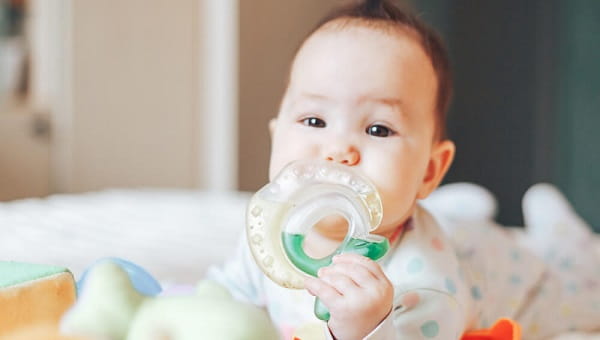A baby’s first tooth can emerge at almost any age—some babies are born with one or more teeth, while others are still gumming their food on their first birthday! Typically, though, you’re likely to see signs of teething within the next few weeks, if not already. The first teeth to come in are usually the two front teeth on the bottom, and then on the top.
Signs of teething
The teething experience is different for every baby, lasting from a day or two before a single tooth pops out, or seemingly forever if your baby has several teeth coming in at the same time. But, here are some signs to look for that could point to baby’s first tooth:
- Trying to bite, chew or suck on anything she can get into her mouth
- Increased desire to breastfeed (see above)
- Drooling a lot, like soaking through a bib and the onesie underneath
- Irritability (teething hurts!)
- Refusing to eat
- Waking often during the night
- Rubbing her face or pulling on her ears (she may not be able to determine the source of the pain)
- Low-grade temperature (around 99°F)
You may be able to see red, swollen gums or even the faint white dot of a tooth just below the gumline.
NOT signs of teething
Despite what you may have heard, a temperature above 100.4°F is not a normal part of teething. Neither are diarrhea, rashes, cough or cold symptoms. If these symptoms persist, you may need to talk to your pediatrician.
Soothing a teething baby
There are lots of ways to help your baby feel better while she waits for that tooth (or teeth) to pop through:
- Give her hard (baby-safe) things to put in her mouth. When she bites, the counter-pressure relieves the pain of the tooth trying to push through. Teething toys of different shapes and sizes are great, because she can find one that fits just right on the sore spot.
- Give her a cold (not frozen) teething ring or washcloth to help numb the pain.
- Give infant ibuprofen or acetaminophen according to package directions. Ibuprofen often works better because it soothes inflammation as well as pain.
- Keep the drool off her face as much as possible, as it can irritate her sensitive skin. You can put petroleum jelly around her mouth and chin as a protective barrier.
- Chilled solid food chunks like apples, potato or carrots in a baby safe feeder.
DON’T use topical teething medications containing lidocaine or benzocaine. These used to be standard care for teething babies, but the FDA released a warning stating that these medications can be dangerous. Also, avoid teething toys with liquid inside as they can develop microscopic tears leading to bacterial contamination.




